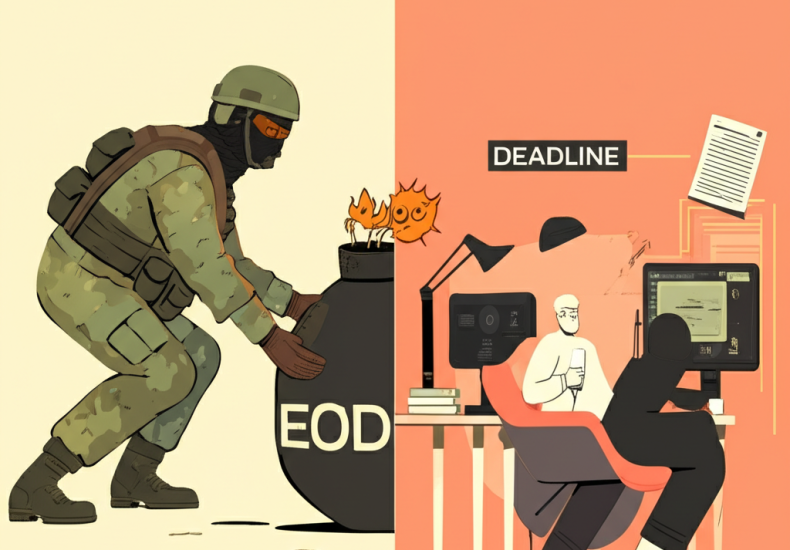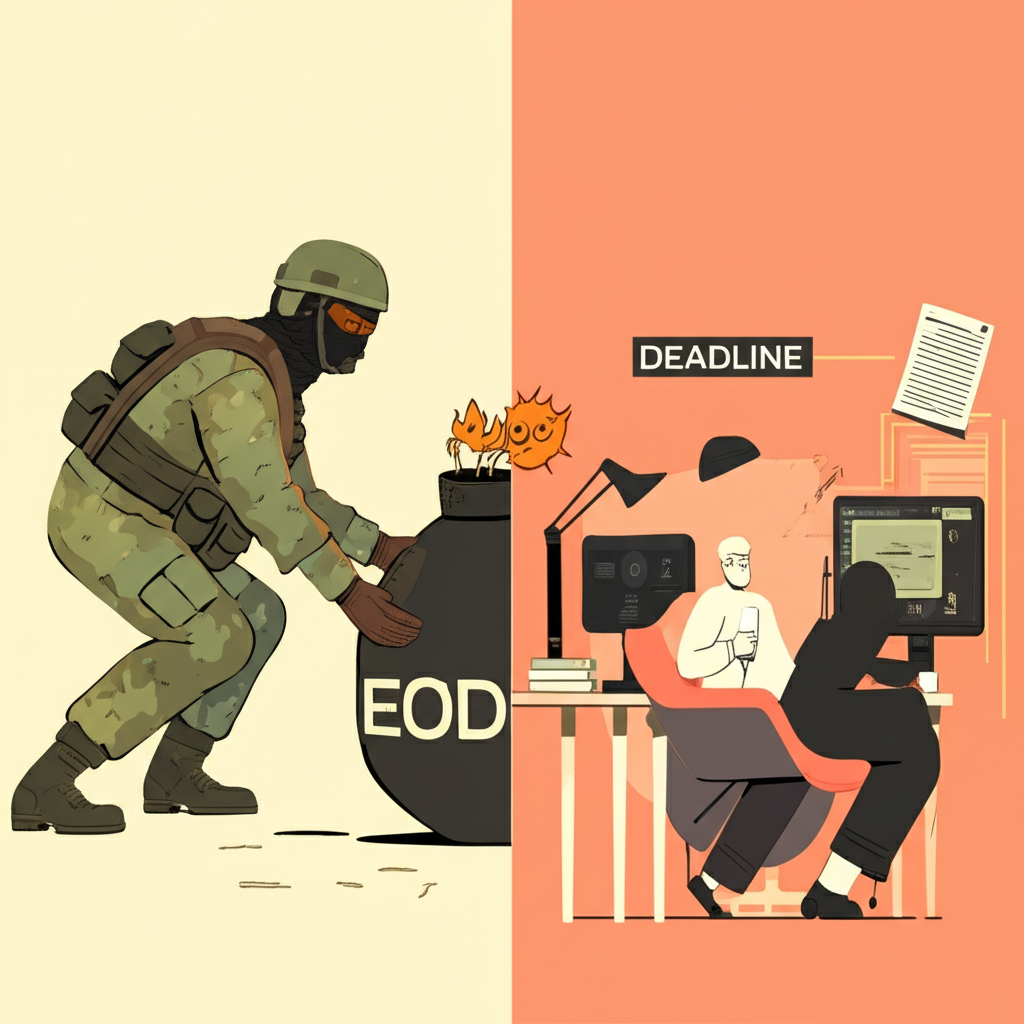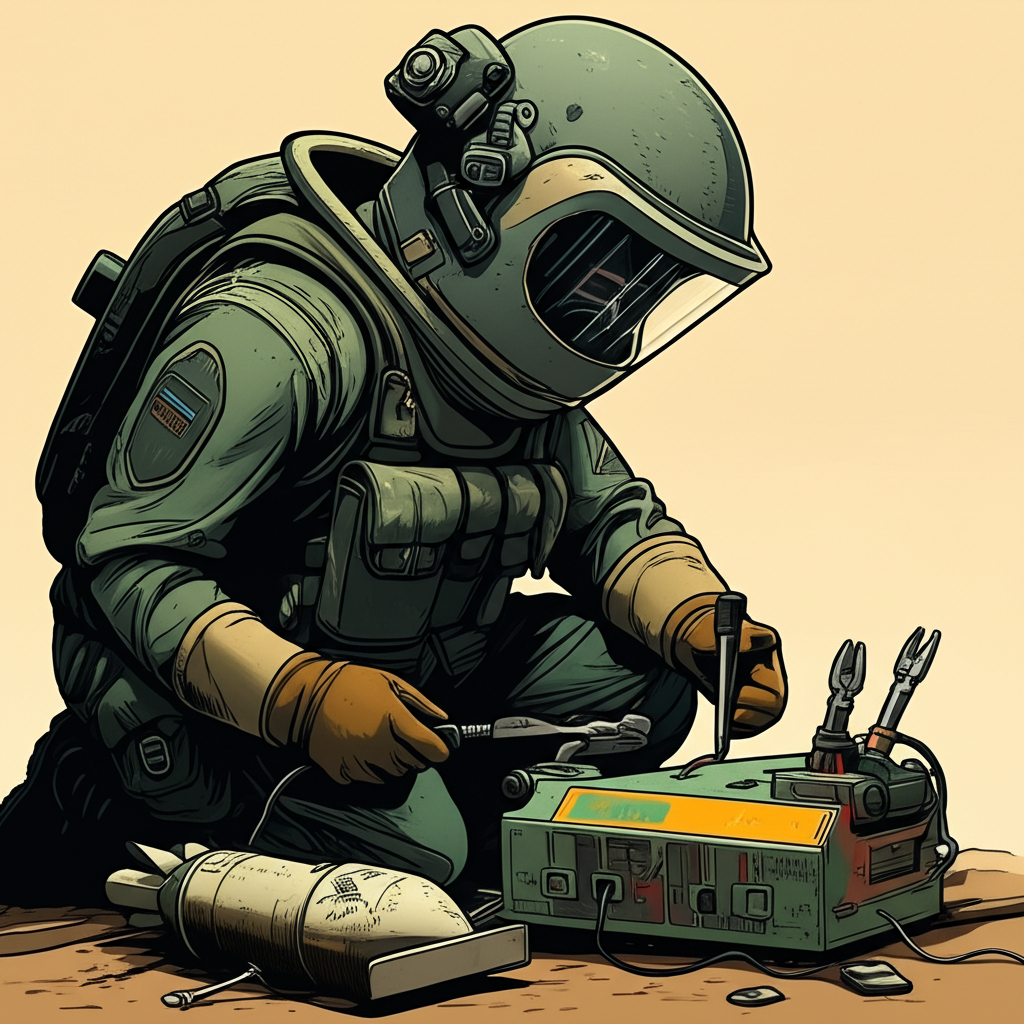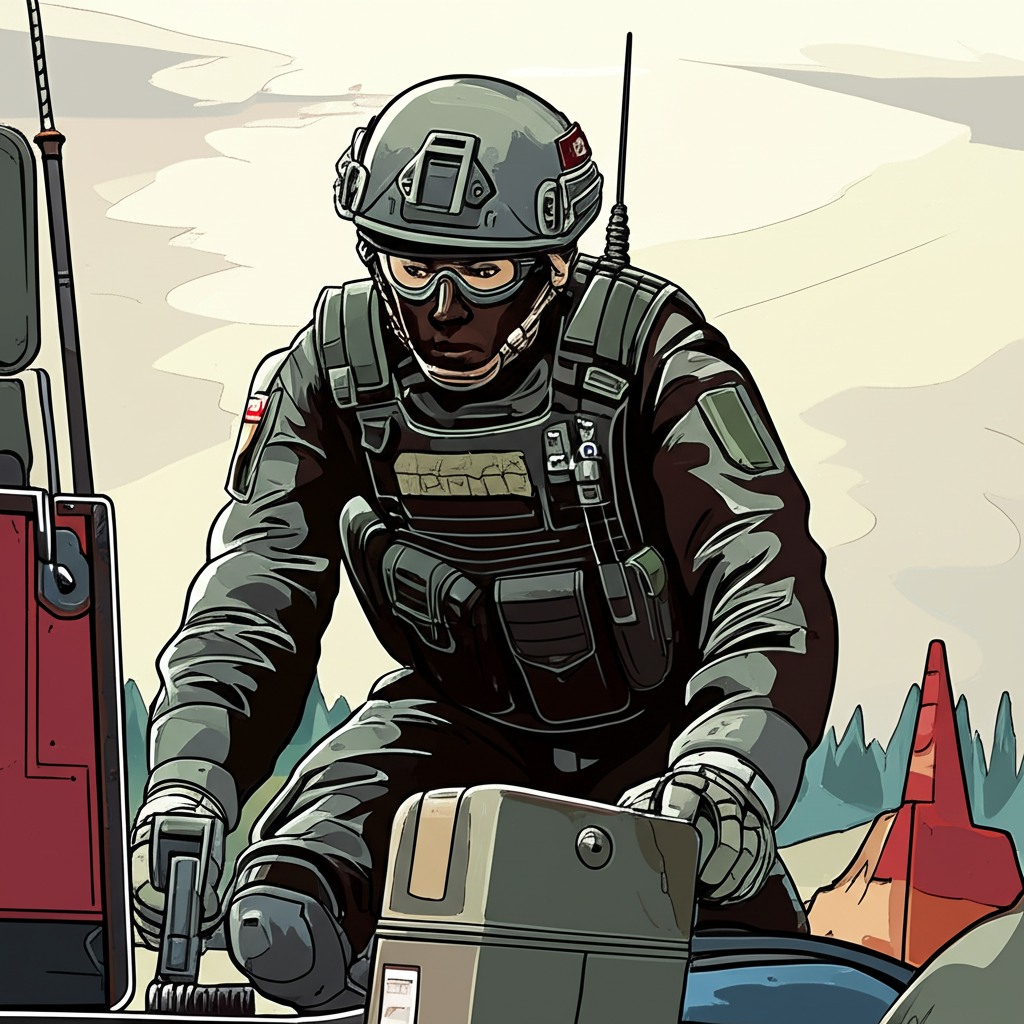
EOD Definition: Unpacking 2 Key Meanings & Why Context Matters
Table of Contents
ToggleIntroduction: Understanding the Multifaceted Meaning of EOD

The term EOD appears frequently across various industries, yet its meaning shifts dramatically depending on the context. In one setting, it describes a high-stakes mission to disarm a live explosive; in another, it marks a simple but urgent office deadline. This duality often leads to confusion—especially when military reports and corporate emails use the same acronym with entirely different implications. To cut through the ambiguity, this article explores the primary meanings of EOD in depth, focusing on its critical roles in defense and business operations. We’ll also examine niche uses, clarify common misunderstandings, and provide practical guidance for interpreting EOD correctly—no matter the environment.
Explosive Ordnance Disposal (EOD): The Military’s Elite Bomb Squad

What is Explosive Ordnance Disposal?
Explosive Ordnance Disposal, commonly abbreviated as EOD, encompasses the full lifecycle of handling dangerous explosives: detection, identification, rendering safe, recovery, and final disposal. This includes unexploded bombs, landmines, chemical or radiological devices, and especially improvised explosive devices (IEDs)—a persistent threat in modern conflict zones. EOD units operate wherever explosive hazards exist, from war-torn regions to urban environments following terrorist attacks. Their work prevents catastrophic loss of life and infrastructure damage, making them indispensable in both combat and peacetime operations. Whether clearing a battlefield or responding to a suspicious package in a city center, EOD teams neutralize threats that could otherwise destabilize entire regions.
The Critical Role of EOD Technicians
EOD technicians are among the most elite and rigorously trained personnel in any armed force. Their job goes far beyond disarming bombs—they analyze explosive materials, gather intelligence on enemy tactics, and often train other military units in threat recognition. These specialists face extreme conditions, including active combat zones, unstable terrain, and hidden booby traps. Their training spans advanced robotics, controlled demolitions, chemical and biological hazard response, and forensic investigation. Every decision is made under intense pressure, where the margin for error is virtually zero. The combination of technical mastery, mental resilience, and physical courage defines the EOD technician’s role—a silent guardian operating at the edge of danger to protect both military and civilian populations.
EOD Across Military Branches (Army, Navy, Air Force)
While the core objective of neutralizing explosive threats remains consistent, each military branch tailors its EOD operations to its operational domain:
- Army EOD: Focuses on ground-based threats, supporting infantry units, clearing post-combat zones, and responding to domestic explosive incidents. Army EOD teams are often first on the scene during counter-terrorism operations or after munitions accidents.
- Navy EOD: Specializes in maritime and underwater threats, including underwater mines, submerged ordnance, and harbor security. These technicians are trained divers who conduct complex salvage and disposal missions, often in support of naval special operations forces. More information on their specialized capabilities can be found on the U.S. Navy EOD website.
- Air Force EOD: Responsible for securing air bases, aircraft, and personnel from explosive risks. They respond to unexploded ordnance on runways, investigate crash sites, and conduct counter-IED operations in deployed environments. Their work ensures mission readiness and flight safety.
A Brief History and Evolution of EOD

Organized bomb disposal efforts began during World War I, but it was World War II that solidified EOD as a formal military discipline. The widespread bombing campaigns left cities littered with unexploded ordnance, necessitating systematic and courageous disposal operations. After the war, EOD units adapted to Cold War threats, including nuclear and chemical weapons. The most transformative period came during the Iraq and Afghanistan conflicts, where insurgents heavily relied on IEDs—leading to rapid advancements in EOD technology. Remote-controlled robots, advanced sensors, and real-time threat analysis became standard tools. Today, EOD is a dynamic, tech-driven field that continues to evolve in response to emerging threats. The U.S. Army Ordnance Corps, for instance, has played a pivotal role in developing these capabilities, as detailed in historical records from the U.S. Army Center of Military History.
End of Day (EOD): A Key Business and Project Management Term
Defining EOD in a Business Context
In corporate environments, EOD stands for “End of Day” and is widely used to set clear deadlines. When a manager says a report is due by EOD, they typically expect it before the standard workday concludes—usually around 5:00 PM local time. This shorthand is essential in fast-moving industries where timely communication and task completion are critical. It helps teams stay aligned, meet project milestones, and maintain accountability. Unlike vague requests like “soon” or “when you can,” EOD establishes a specific timeframe, reducing ambiguity and improving workflow efficiency.
EOD vs. COB: Understanding the Nuances
Although “End of Day” (EOD) and “Close of Business” (COB) are often used interchangeably, subtle differences can affect interpretation:
| Term | Meaning | Common Interpretation | Nuance/Regional Variation |
|---|---|---|---|
| EOD (End of Day) | Completion by the end of standard working hours. | Usually 5:00 PM in the sender’s local time zone. | Can sometimes be interpreted as midnight, though less common in formal business. |
| COB (Close of Business) | Completion by the time business operations cease. | More explicitly tied to the official closing time of an office, often 5:00 PM or 6:00 PM. | Stronger emphasis on the *official* end of the workday, often implying no work will be done after this. |
For global teams, these distinctions matter. A request for “EOD” from a colleague in New York may mean 5:00 PM EST, while a team member in Tokyo might interpret it differently unless specified. To avoid confusion, especially in international collaborations, it’s wise to confirm time zones or use precise timestamps.
Practical Applications of EOD in the Workplace
EOD is more than just office jargon—it’s a cornerstone of operational clarity. Project managers rely on it to track deliverables and keep initiatives on schedule. Sales teams use EOD deadlines to finalize proposals or confirm client agreements before the day ends. In finance, reconciliations, transaction reports, and market updates are often due by EOD to ensure data accuracy for the next business cycle. Customer support teams might log all resolved tickets by EOD for daily performance tracking. Even in casual communication, saying “Please send the updated budget by EOD” sets a clear expectation without overcomplicating the message. Its widespread adoption reflects its value in promoting accountability and time management.
Other Meanings and Lesser-Known Contexts of EOD
EOD in Aviation and Other Specialized Fields
Beyond defense and business, EOD occasionally appears in niche sectors. In aviation administration or government HR systems, EOD may stand for “Entry On Duty,” indicating the official start date of an employee’s service. This usage is primarily administrative and appears in personnel records or onboarding documentation. While not common in operational aviation contexts like flight control or aircraft maintenance, it serves a functional role in workforce management. Similarly, in some technical or regulatory documents, EOD might refer to a specific process or component, though these uses are industry-specific and not widely recognized outside their respective fields.
EOD in Medical or Police Contexts
Police bomb squads function similarly to military EOD units, often employing the same protocols and equipment for civilian explosive threats. Many law enforcement EOD teams receive joint training with military counterparts, ensuring consistency in response standards. However, within general medical practice, EOD is not a standard acronym. While terms like “Esophagoduodenoscopy” coincidentally form the same letters, it is not commonly abbreviated as EOD in clinical settings. Medical professionals typically use more specific and widely accepted abbreviations, so EOD does not carry any recognized medical meaning in routine practice.
Is There a Slang or Informal EOD?
Unlike many acronyms that develop casual or humorous interpretations, EOD remains firmly rooted in professional usage. Its associations with life-threatening situations in the military and time-sensitive expectations in business discourage informal or playful adaptations. There is no widespread slang version of EOD in popular culture or digital communication. It maintains a serious tone across all contexts, reinforcing its role as a precise and consequential term rather than a conversational shorthand.
Common Misconceptions and Key Takeaways
One of the most frequent misunderstandings is assuming EOD always refers to bomb disposal. While that meaning carries dramatic weight, it’s not the one most people encounter in daily work life. Conversely, professionals in non-military fields might be unaware that EOD represents a real, high-risk military specialty. The key to accurate interpretation lies in context.
When you come across EOD, consider the environment:
- In military, defense, or security-related content: It almost certainly means Explosive Ordnance Disposal.
- In emails, project timelines, or corporate discussions: It refers to End of Day as a deadline.
- In HR, government, or administrative documents: Check for clues—EOD might mean Entry On Duty.
By paying attention to context, you avoid miscommunication and respond appropriately—whether that means suiting up for a bomb site or simply hitting “send” before leaving the office.
Conclusion: EOD’s Impact Across Diverse Domains
EOD may be just three letters, but its implications span from life-or-death decisions in war zones to productivity benchmarks in corporate offices. In the military, it represents a commitment to safety, precision, and courage under fire. In business, it symbolizes efficiency, accountability, and time management. Though the meanings differ, both underscore the importance of clarity and responsibility. Recognizing which EOD is in play at any given moment ensures better communication, fewer errors, and greater respect for the roles these terms represent. Whether disarming a bomb or meeting a deadline, EOD reminds us that timing, expertise, and context shape outcomes in powerful ways.
Frequently Asked Questions About EOD
What are the two most common meanings of EOD?
The two most common meanings of EOD are “Explosive Ordnance Disposal” (primarily military) and “End of Day” (primarily business and project management).
In the military, what does EOD specifically refer to?
In the military, EOD specifically refers to “Explosive Ordnance Disposal.” This involves the detection, identification, rendering safe, recovery, and disposal of explosive devices, including bombs, mines, and improvised explosive devices (IEDs).
When a colleague says “send it by EOD,” what exactly do they mean?
When a colleague says “send it by EOD,” they mean they expect the item or task to be completed and submitted before the end of the standard business day, typically around 5:00 PM in their local time zone.
How does EOD in business differ from COB (Close of Business)?
While often used interchangeably, EOD (End of Day) is a general reference to the end of the workday, whereas COB (Close of Business) more explicitly refers to the official closing time of an office or business operations. Both typically imply a deadline around 5:00 PM or 6:00 PM local time.
What kind of training is required to become an Explosive Ordnance Disposal technician?
Becoming an EOD technician requires extensive and rigorous training that covers advanced robotics, demolition, bomb disarming techniques, chemical/biological threat response, and forensic analysis. It’s one of the most demanding specialties in the military.
Are there any less common or industry-specific definitions for EOD?
Yes, in some specialized fields, EOD can have other meanings. For instance, in government or aviation administration, it might stand for “Entry On Duty,” referring to a start date for employment. However, these are less common than its military and business definitions.
What is the historical significance of military EOD units?
Military EOD units gained significant importance during World War II due to the proliferation of unexploded ordnance. They have continuously evolved, particularly with the rise of improvised explosive devices (IEDs) in modern conflicts, becoming crucial for both military operations and civilian protection.
Can EOD be used in a medical context, and if so, what does it mean?
EOD is not a commonly recognized or widely used abbreviation in general medical contexts. While very niche or obscure medical terms might coincidentally form the acronym EOD (e.g., Esophagoduodenoscopy), it is not a standard medical abbreviation you would typically encounter.
Is “EOD” a term used in aviation, and what does it signify?
In some aviation-related administrative or human resources contexts, EOD might stand for “Entry On Duty,” similar to its usage in other government sectors. However, it is not a primary operational term within aviation itself for flight operations or maintenance.
What are the key dangers associated with the work of military EOD personnel?
The work of military EOD personnel is extremely dangerous, involving direct interaction with live explosives. Key dangers include accidental detonation, chemical/biological exposure, booby traps, and operating in hazardous environments under combat conditions. It demands unparalleled bravery, precision, and adherence to safety protocols.
You may also like
Calendar
| 一 | 二 | 三 | 四 | 五 | 六 | 日 |
|---|---|---|---|---|---|---|
| 1 | 2 | 3 | 4 | 5 | 6 | 7 |
| 8 | 9 | 10 | 11 | 12 | 13 | 14 |
| 15 | 16 | 17 | 18 | 19 | 20 | 21 |
| 22 | 23 | 24 | 25 | 26 | 27 | 28 |
| 29 | 30 | 31 | ||||
發佈留言
很抱歉,必須登入網站才能發佈留言。